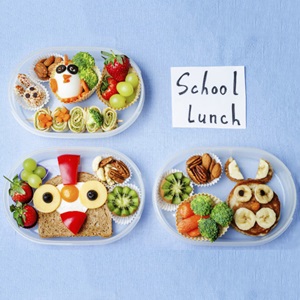Preschooler Nutrition
Helpful feeding information for your preschooler
Preschool-age children (ages 3 to 5) are still developing their eating habits and need encouragement to eat healthy meals and snacks. These children are eager to learn, especially from other people. They will often imitate eating behaviors of adults. They need supervision at mealtime as they are still working on chewing and swallowing skills.
The following are some helpful mealtime hints for preschool-age children:
-
Prepare meals, provide regularly scheduled snacks, and limit unplanned eating.
-
Poor behavior at mealtime should not be allowed. Focus on eating, not playing with food, or playing at the dinner table.
-
Running or playing while eating can cause a child to choke. Have your child sit when eating.
-
Keep offering a variety of foods. Have the attitude that, sooner or later, your child will learn to eat almost all foods.
-
Make mealtime as pleasant as possible. Do not put pressure on your child to eat. Do not force your child to "clean" his or her plate. This may lead to overeating, which can cause your child to gain too much weight. Children will be hungry at mealtime if snacks have been limited during the day.
-
Provide examples of healthy eating habits. Preschoolers copy what they see their parents doing. If you have unhealthy eating habits, your child will not learn to eat healthy.
Healthy food choices
The MyPlate icon is a guideline to help you and your child eat a healthy diet. MyPlate can help you and your child eat a variety of foods while encouraging the right amount of calories and fat.
The USDA and the U.S. Department of Health and Human Services have prepared food plates to guide parents in selecting foods for children age 2 and older.
The MyPlate icon is divided into 5 food group categories, emphasizing the nutritional intake of the following:
-
Grains. Foods that are made from wheat, rice, oats, cornmeal, barley, or another cereal grain are grain products. Examples include whole wheat, brown rice, and oatmeal.
-
Vegetables. Vary your vegetables. Choose a variety of colorful vegetables. These can include dark green, red, and orange vegetables, legumes (peas and beans), and starchy vegetables.
-
Fruits. Any fruit or 100% fruit juice counts as part of the fruit group. Fruits may be fresh, canned, frozen, or dried, and may be whole, cut up, or pureed.
-
Dairy. Milk products and many foods made from milk are considered part of this food group. Focus on fat-free or low-fat products, as well as those that are high in calcium.
-
Protein. Go lean on protein. Choose low-fat or lean meats and poultry. Vary your protein routine. Choose more fish, nuts, seeds, peas, and beans.
Oils are not a food group, yet some, like nut oils, contain essential nutrients and can be included in the diet. Animal fats, which are solid fats, should be avoided.
Exercise and everyday physical activity should also be included with a healthy dietary plan.
7 School Lunch Tips for Picky Eaters

Getting your child to eat healthfully is a struggle for many parents, especially if you have a picky eater in your family. Picky eaters often bring back unopened lunch boxes or ignore the healthy foods you’ve packed and go straight for the dessert. Learn helpful tips and tricks for outsmarting your picky eater from a Johns Hopkins pediatric dietitian.
Nutrition and activity tips
Here are some tips to follow:
-
Try to control when and where food is eaten by your children by providing regular daily meal times with social interaction and demonstration of healthy eating behaviors.
-
Involve children in the selection and preparation of foods. Teach them to make healthy choices by helping them to select foods based on their nutritional value.
-
For children in general, reported dietary intakes of the following are low enough to be of concern by the USDA: calcium, magnesium, potassium, and fiber. Select foods with these nutrients when possible.
-
Most Americans need to reduce the number of calories they consume. When it comes to weight control, calories do count. Controlling portion sizes and eating nonprocessed foods helps limit calorie intake and increase nutrients.
-
Parents are encouraged to provide recommended serving sizes for children.
-
Parents are encouraged to limit children’s video, television watching, and computer use to less than 2 hours daily. Replace sitting activities with activities that require more movement.
-
Children and adolescents need at least 60 minutes of moderate to vigorous physical activity on most days to have good health and fitness and for healthy weight during growth.
-
To prevent dehydration, encourage children to drink fluid regularly during physical activity and drink several glasses of water or other fluid after the physical activity is completed.
To find more information about the Dietary Guidelines for Americans 2015–2020 and to determine the appropriate dietary recommendations for your child’s age, sex, and physical activity level, visit the Online Resources page for the links to the ChooseMyPlate.gov and 2015–2020 Dietary Guidelines sites. Please note that the MyPlate plan is designed for people older than age 2 who do not have chronic health conditions.
Always talk with your child’s health care provider regarding his or her healthy diet and exercise requirements.





